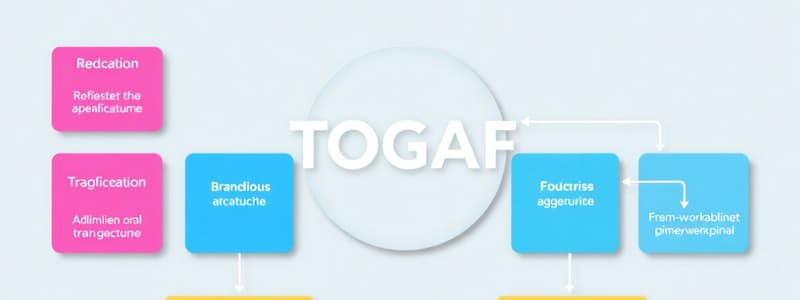Podcast
Questions and Answers
What is the primary purpose of Enterprise Architecture?
What is the primary purpose of Enterprise Architecture?
- To implement only software solutions to business problems
- To limit technological changes within an organization
- To provide a blueprint for managing and aligning IT with business goals (correct)
- To exclusively focus on hardware infrastructure
Which layer of Enterprise Architecture primarily deals with business processes?
Which layer of Enterprise Architecture primarily deals with business processes?
- Application layer
- Data layer
- Technology layer
- Business layer (correct)
What does the term 'capability' refer to in the context of Enterprise Architecture?
What does the term 'capability' refer to in the context of Enterprise Architecture?
- An organization's ability to perform a set of related tasks (correct)
- The hardware components of the IT infrastructure
- A specific software tool used within the organization
- The financial resources available for IT projects
Which framework is commonly used for developing Enterprise Architecture?
Which framework is commonly used for developing Enterprise Architecture?
What is a key benefit of implementing Enterprise Architecture in an organization?
What is a key benefit of implementing Enterprise Architecture in an organization?
In a scenario where a company is planning to upgrade its IT infrastructure, which aspect of Enterprise Architecture should be prioritized to ensure alignment with business goals?
In a scenario where a company is planning to upgrade its IT infrastructure, which aspect of Enterprise Architecture should be prioritized to ensure alignment with business goals?
What role does the Data Architecture layer play in Enterprise Architecture?
What role does the Data Architecture layer play in Enterprise Architecture?
During a digital transformation initiative, a company's IT department needs to select a cloud service provider. Which aspect of Enterprise Architecture should be emphasized?
During a digital transformation initiative, a company's IT department needs to select a cloud service provider. Which aspect of Enterprise Architecture should be emphasized?
Which component of Enterprise Architecture helps identify gaps between current capabilities and future requirements?
Which component of Enterprise Architecture helps identify gaps between current capabilities and future requirements?
In an organization that has established a clear Enterprise Architecture framework, what is a common challenge when trying to implement new technologies?
In an organization that has established a clear Enterprise Architecture framework, what is a common challenge when trying to implement new technologies?
In an organization looking to enhance its IT infrastructure, which concept of Enterprise Architecture would help create a roadmap for integrating new technologies?
In an organization looking to enhance its IT infrastructure, which concept of Enterprise Architecture would help create a roadmap for integrating new technologies?
What is a major challenge organizations face when trying to maintain an Enterprise Architecture in a rapidly changing IT environment?
What is a major challenge organizations face when trying to maintain an Enterprise Architecture in a rapidly changing IT environment?
If a company is implementing a new Customer Relationship Management (CRM) system, which aspect of Enterprise Architecture should be closely reviewed to ensure system effectiveness?
If a company is implementing a new Customer Relationship Management (CRM) system, which aspect of Enterprise Architecture should be closely reviewed to ensure system effectiveness?
In a scenario where a firm is assessing existing software to optimize its Enterprise Architecture, which component would be critical in evaluating how current software aligns with future organizational goals?
In a scenario where a firm is assessing existing software to optimize its Enterprise Architecture, which component would be critical in evaluating how current software aligns with future organizational goals?
Which of the following best describes a strategic advantage of having a well-defined Enterprise Architecture in place when considering mergers or acquisitions?
Which of the following best describes a strategic advantage of having a well-defined Enterprise Architecture in place when considering mergers or acquisitions?
Flashcards are hidden until you start studying
Study Notes
Enterprise Architecture Purpose
- Aligning IT with business strategy, ensuring technology supports business goals.
Business Process Layer
- Business Architecture, typically focusing on processes, data, and organizational structures.
Capability Definition
- A set of skills, resources, and procedures that enable an organization to perform a specific function or task.
Popular Framework
- TOGAF (The Open Group Architecture Framework) is a widely used standard for developing Enterprise Architecture.
Key Benefit of Implementing Enterprise Architecture
- Improved decision-making by providing a comprehensive view of the organization's IT infrastructure and its alignment with business goals.
Enterprise Architecture Purpose
- Aligns IT with business goals and objectives.
- Provides a blueprint for technology investments and decisions.
Business Process Layer
- Business Architecture layer focuses on business processes, functions, and capabilities.
Capability in Enterprise Architecture
- Represents an organization's ability to perform a specific activity or set of activities that deliver value to customers or stakeholders.
Commonly Used Framework
- TOGAF (The Open Group Architecture Framework) is a widely used framework for developing Enterprise Architecture.
Key Benefit of Enterprise Architecture Implementation
- Improved agility and adaptability, allowing organizations to respond quickly to changing market conditions and technological advancements.
Prioritized Aspect for IT Infrastructure Upgrade
- Application Architecture should be prioritized to ensure alignment with business goals and facilitate the effective use of the upgraded infrastructure.
Data Architecture Layer Role
- Defines the overall structure, organization, and management of data within an organization.
- Ensures data consistency, integrity, and accessibility across different systems and applications.
Emphasized Aspect for Cloud Service Provider Selection
- Technology Architecture is crucial for evaluating and selecting a cloud service provider that meets the organization's technical requirements and security standards.
Gap Identification Component
- Gap Analysis helps identify discrepancies between current capabilities and future requirements, highlighting areas where improvements are needed.
Common Challenge During Technology Implementation
- Resistance to change from employees who are accustomed to existing processes and systems.
- Overcoming this challenge requires effective communication, training, and change management strategies.
Purpose of Enterprise Architecture
- To align IT with business strategy and ensure the organization's technology infrastructure supports its goals.
Business Process Layer
- The Business Architecture layer focuses on the organization's processes and how they are designed to achieve its business goals.
Capability in Enterprise Architecture
- A capability refers to the organization's ability to perform a specific task or deliver a service.
Commonly Used Enterprise Architecture Framework
- The TOGAF (The Open Group Architecture Framework) is a widely adopted framework for developing Enterprise Architecture.
Benefit of Implementing Enterprise Architecture in an Organization
- Improved decision-making by providing a comprehensive view of the organization's technology landscape.
Prioritized Aspect of Enterprise Architecture for IT Infrastructure Upgrade
- The Business Architecture layer should be prioritized to ensure the upgrade aligns with the organization's business goals.
Role of Data Architecture Layer
- The Data Architecture layer focuses on data management, including how data is stored, accessed, and used across the organization.
Emphasized Aspect of Enterprise Architecture for Cloud Service Selection
- The Technology Architecture layer should be emphasized to ensure the chosen cloud service provider meets the organization's technical requirements.
Identifying Gaps between Capabilities and Requirements
- The Gap Analysis component of Enterprise Architecture helps identify gaps between current capabilities and future requirements.
Common Challenge for Implementing New Technologies
- Resistance to change from stakeholders who may be concerned about the impact of new technologies on their roles and responsibilities.
Concept for Creating a Technology Integration Roadmap
- The Technology Architecture layer provides a roadmap for integrating new technologies and ensuring consistency across the IT infrastructure.
Challenge for Maintaining Enterprise Architecture in a Dynamic IT Environment
- Keeping the architecture updated and relevant in a rapidly evolving IT landscape is a major challenge.
Aspect to Review When Implementing a CRM System
- The Application Architecture layer should be closely reviewed to ensure the CRM system integrates well with existing applications and aligns with the organization's business processes.
Component for Evaluating Software Alignment with Business Goals
- The Application Architecture layer is critical in evaluating how current software aligns with future organizational goals.
Strategic Advantage of a Defined Enterprise Architecture During Mergers and Acquisitions
- A well-defined Enterprise Architecture provides a clear understanding of the target company's technology landscape, enabling smoother integration and cost savings in post-merger processes.
Studying That Suits You
Use AI to generate personalized quizzes and flashcards to suit your learning preferences.



